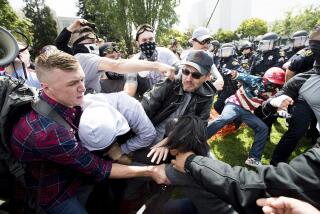Despite Image, Liberal Judges No Longer Rule 9th Circuit
SAN FRANCISCO — The U. S. 9th Circuit Court of Appeals, the largest judicial empire in the United States, seemingly cannot escape its reputation as a liberal haven.
Decisions such as the one issued Monday night granting condemned murderer Robert Alton Harris a last-minute stay of execution only add to the image.
A few years ago, the liberal label was undeniably deserved, but no more.
In 1984, the court, made up of predominantly liberal appointees, was reversed 27 of 28 times by the U. S. Supreme Court.
Since then, the makeup of the 28-judge court has been radically altered by more than a dozen conservative appointments during the Reagan and Bush years. During the U. S. Supreme Court’s 1990 term, the 9th Circuit’s reversal rate dropped to 12.3%, putting it exactly in the middle of the 13 circuits, according to the Administrative Office of the U. S. Courts in Washington.
The 28 full-time and 11 part-time judges live throughout the West, from California to Alaska and from Idaho to Hawaii. The San Francisco-based court handles more than 5,000 appeals a year from trial courts in California, eight other Western states and two Pacific territories--Guam and the Northern Mariana Islands.
ThS. Supreme Court takes appeals from the circuit courts but because the high court decides so few cases, most federal issues, including the civil rights and constitutional law issues raised in the Harris case, are thrashed out at the circuit court level.
Normally, the court meets as three-judge panels for hearings in various cities, then issues opinions in San Francisco, Pasadena, Portland and Seattle. A three-judge panel can rule unanimously or by a 2-1 decision.
To prevent conflicts and overlap, cases involving the same person or similar issues are directed to one panel. Judges Arthur L. Alarcon of Los Angeles, John T. Noonan of San Francisco and Melvin Brunetti of Reno have handled the Harris case for years.
The Harris defense request for expanded review that prompted the stay of execution is a common appeal procedure. The loser in a decision by a three-judge panel frequently asks the entire court to look at the ruling afresh. That expanded review--called en banc review--is rarely granted, however.
Because of the size of the 9th Circuit, expanded review comes with a twist.
In other federal appeals courts, expanded review involves all the full-time judges on the court. Rather than 28 judges, however, an en banc hearing in the 9th Circuit involves 11 judges.
But to convene the 11 judges, a majority vote from the 28 judges is required. The chief judge of the circuit, J. Clifford Wallace of San Diego, sits on all 11-judge panels. The other 10 judges are selected randomly.
More to Read
Get the L.A. Times Politics newsletter
Deeply reported insights into legislation, politics and policy from Sacramento, Washington and beyond. In your inbox three times per week.
You may occasionally receive promotional content from the Los Angeles Times.










